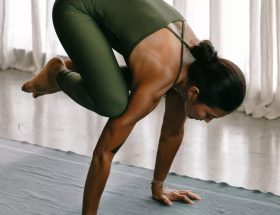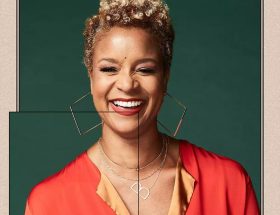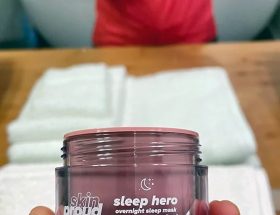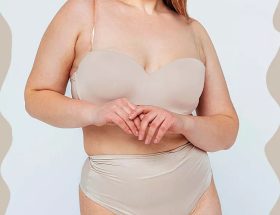How to Pick the Right Exercise Ball for You
Exercise balls are a dynamic, active, and fun addition to liven up your everyday workout routine. Available in various sizes and colors, and typically made from vinyl or PVC plastic, this lightweight, inflatable apparatus is mighty enough to bring a shake to all of your muscles. And yes, it’s killer for your core!
So whether you’re in an exercise funk, or you are looking for inspiration to spruce up your abs routine, the affordable and multifunctional exercise ball may be the answer.
Laura Flynn Endres is a personal trainer and the founder of the online team fitness game, Get Fit Done.
Tatiana Koval is a Studio SWEAT onDemand trainer.
What Is an Exercise Ball?
Commonly known as a stability ball, this nifty piece of equipment has many uses. For example, exercise balls are becoming increasingly popular in the workspace as an ergonomic office chair, the benefit being that it forces trunk activation and optimal posture—great for counterbalancing time at your desk! And on the gym floor, it’s a go-to accessory to complement almost any training style.
“It’s an excellent addition for any workout program, as you can use an exercise ball to work on stability (hence the name), flexibility, strength, and balance,” explains personal trainer Laura Flynn Endres. “Think of a kid’s ball you find at any playground but only bigger, made of durable material, and light enough to roll and challenge your muscle control.”
Although the majority are filled with air, according to Flynn Endres, some contain a small amount of sand to keep them from rolling. “This makes them heavier, which adds a bit of resistance if you’re holding them over your body, for example,” she says.
What Sizes Are Available?
“Exercise balls are typically available in five different sizes, and you should select the right fit based mainly on your height,” details Studio SWEAT onDemand trainer Tatiana Koval.
To measure this, Koval explains that when you are seated and upright on the exercise ball, your feet should be flat on the floor with your weight distributed evenly between them. If they fail to touch the floor, then size down. “You want your knees to be level or slightly lower than your pelvis, so if your knees are too high, then go for a size up.”
In number terms, their diameters range from around 45 to 85 cm. “You’ll want to choose a ball that’s proportional to your height, so someone who’s around five-feet tall will likely use a 45 cm ball, whereas someone who’s closer to six feet will fall somewhere in between a 65 or 75 cm ball,” adds Flynn Endres.
A few factors to note are the degree of bend in your knees, which should be around 90 or a bit higher. And also take note of how inflated the ball is, to avoid sinking down when seated.
Exercise Ball Workouts
Whether your goal is to obtain a rock solid core, or build up definition in the glutes, exercise balls serve as a multifunctional tool to work every part of the body.
“There are many effective exercises with an exercise ball that can slot into any workout,” says Koval. For example:
V-Sit Ups: Place your feet up on the ball and, with a neutral spine, perform a V sit-up.
Knee Tuck: In a full plank position, place your feet on the ball and roll it back and forth to crunch at the core and complete a knee tuck.
Classic Squat: Increase the level of difficulty by holding the exercise ball over your head as you squat up and down.
Elevated Push-Up: Challenge your push-ups by elevating your feet on the ball in plank, which, as an added bonus, will encourage the core to work hard to keep you stabilized.
To level up the core challenge, Flynn Endres suggests holding a plank with your elbows on the exercise ball, remembering the narrower your foot stance, the more tricky it is to balance. Her favorite mix of exercise ball moves include:
Hip Raises: Place the heels and calves on the ball and raise the hips up to form a straight line running from your shoulders to your hips and knees. Lower the body back down with control to work the glutes and lower back. This requires balance and stability, e.g., core activation, to keep your legs from rolling off to one side.
Dead Bug: Lying on your back, press the ball between your palms and knees before reaching away with one arm and one leg.
Hamstring Curls: Lie face-up on the floor with your heels and calves on the ball, then bend your knees to pull the ball toward you with your heels. This will fire up your hamstrings more than you imagine.
Wall Sits or Wall Squats: Stand with a ball held between your lower back and a wall, step your feet forward a few inches, then squat down and up. Or, lower into a squat and hold there. This changes the focus of squats to include more posterior muscle engagement.
“The exercise ball is also a useful stretching tool, like lying face down over the ball and letting your head hang toward the floor for your back to relax and open up,” Flynn Endres explains. “Conversely, lie face up with the ball centered on your back and maintain a wide stance with your feet for balance, letting your head hang back and your arms fall open and wide.” Here, you should feel a lengthening stretch through the front of your body.
Or, you can sit on the floor with your legs straight and opened wide into a V. With the ball between your thighs and your palms on the ball, come into a forward bend, reaching the ball away with your hands.
Safety Considerations
Remember, the exercise ball is designed to roll, so one of the main safety concerns is falling off. To avoid this, start off with more basic movements before attempting anything more ambitious.
“Practice a few exercises that don’t require your full weight to balance on the ball, and continue to build up your core control (and confidence) before attempting more advanced ball exercises,” suggests Flynn Endres.
Another safety consideration is the integrity of the ball. “They do wear out, and they can pop after years of overuse, when the ball is overinflated, or even when it’s used outside on rough surfaces,” says Flynn Endres. For this reason, it’s best to run your hands over the entire surface of the ball to check for areas of wear and tear before commencing exercise. Most balls are built to be burst-resistant, but it has been known to happen.
On another note: “Having a ball that is the right size and performing the exercise properly will go a long way in preventing injury as you can better stabilize and reduce the risk of sliding off,” says Koval. “If unsure, ask a trained professional to show you how to use the ball, or watch as a trainer demonstrates, so you can be sure you are using the ball properly.”
The Final Takeaway
Exercise balls are a fun, affordable, and dynamic exercise tool that add variety to your workouts and challenge multiple muscles across the entire body. As they are sold in various sizes, finding the right fit based on your height is important in order to get the most benefit from the workout.
The exercise ball is a core-centric addition to level-up any workout, whether you’re targeting the abs, arms, back, or legs. Be mindful of sticking to your limitations before attempting more advanced variations. More complicated exercises require a degree of core control, and there is a risk of falling off the ball with insufficient practice. Overall, this dynamite apparatus will add variety to your workouts.










